
The Arab was a high-performance English automobile designed by Reid Railton and manufactured in Letchworth, Hertfordshire, between 1926 and 1928. The factory had previously been used by the Phoenix car company.
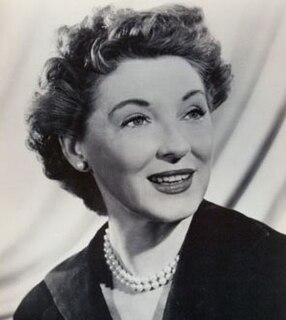
Kathleen "Kay" Walsh was an English actress and dancer. Her film career prospered after she met her future husband film director David Lean, with whom she worked on prestige productions such as In Which We Serve and Great Expectations. (The 1956 'Picture Show Who's Who on the Screen' annual, gives, on page 153, her date of birth as "1914", and her height as " 5' 4" ").
The Dawson Car Company was formed in June 1918 by AJ Dawson, previously works manager at Hillman and designer of the 1913 Hillman Nine car and launched in 1919.

The Silver Wraith was the first post-war Rolls-Royce. It was made from 1946 to 1958 as only a chassis at Rolls-Royce's former Merlin engine plant, their Crewe factory, alongside the shorter Bentley Mark VI. The Bentley too was available as a chassis for coachbuilders but also for the first time could be bought with a Rolls-Royce built standard steel body.

The Bentley 6½ Litre and the high-performance Bentley Speed Six were rolling chassis in production from 1926 to 1930. The Speed Six, introduced in 1928, would become the most successful racing Bentley. Two Bentley Speed Sixes became known as the Blue Train Bentleys after their owner Woolf Barnato's involvement in the Blue Train Races of 1930.
The Bentley 4 Litre was a motor car built on rolling chassis made by Bentley Motors Limited. The 4 litre chassis was conceived and built in a failed attempt to restore Bentley to a good financial state. Announced 15 May 1931, it used a modified four litre Ricardo IOE engine in a shortened 8 litre chassis at two-thirds of the price of the 8 Litre in an attempt to compete with the Rolls-Royce 20/25. Instead, Bentley went into receivership shortly afterward, from which it was purchased by Rolls-Royce Limited.

The Triumph Super 7 was a car manufactured from 1927 to 1934 by the Triumph Motor Company. It was produced as a response to the success of the Austin 7 and was Triumph's first car to be made in large numbers. In 1933 the name was changed to the Triumph Super 8.

The Bond Equipe is an English 2+2 sports car, manufactured by Bond Cars Ltd from 1963 to 1970. It was the first 4-wheeled vehicle from Bond Cars.

The Triumph Dolomite is a car that was produced by Triumph Motor Company from 1934 to 1940. It first appeared in 1934 as a sports car and the name was also used from 1937 on a series of sporting saloons and open cars until 1939 when the company went into receivership. A number were still sold and registered in 1940, though it is uncertain whether the receiver or new owner turned out cars from spare parts, or sold off completed cars. All except the Straight 8 featured a "waterfall" grille styled by Walter Belgrove, versions of the saloons with conventional grilles were sold as Continental models.
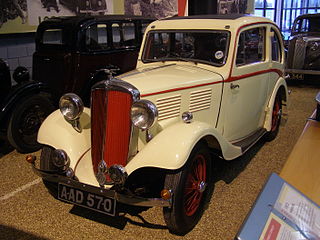
The Standard Ten was a model name given to several small cars produced by the British Standard Motor Company between 1906 and 1961. The name was a reference to the car's fiscal horsepower, a function of the surface area of the pistons. This system quickly became obsolete as an estimate of the power produced by the engine, but it continued to be relevant as a way to classify cars for tax purposes. Like other manufacturers, Standard continued to use the name to define the approximate size of their 'Ten' model long after the origins of the name had, in Britain, become inapplicable.

The Triumph Gloria is a car which was produced by the Triumph Motor Company in Coventry, England, from 1934 to 1938.

The Triumph Renown is strictly the name given to the Triumph's large saloon car made from 1949 to 1954 but it is, in reality, part of a three-car series of the 1800, 2000 and Renown models. Together with the Triumph Roadster, they were the first vehicles to carry the Triumph badge following the company's takeover by the Standard Motor Company.
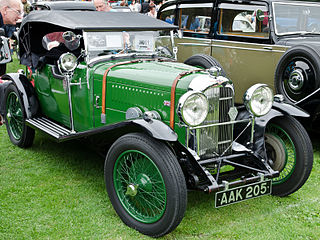
The Lagonda Rapier was a small car produced by the British Lagonda company from 1934 to 1935. A few more were subsequently produced by the independent Rapier Car Company.
The Flying Standard Fourteen is an automobile produced by the British Standard Motor Company from 1936 to 1940 announced in October 1936. The other Flying Standard models had been announced twelve months earlier. A standard is a flag and the reference to flying standards is to flying flags as well as to the advertised abilities of the cars.
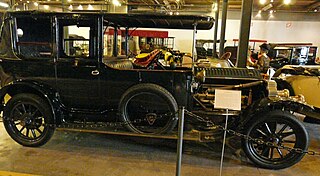
The Vauxhall 27, 30 and 35 h.p. is a large six cylinder car manufactured by Vauxhall from 1910 to 1914. The 27 h.p. was Vauxhall's first six-cylinder car.

The Triumph Super 9 was first introduced by the Triumph Motor Company in 1931 at a price of £185. It continued through into 1933. It had an RAC rating of 8.9 hp.
Beacon Motors Ltd was a British automobile manufacturer based in Hindhead, Surrey from 1912-1913 moving to Liphook, Surrey until 1914.
The Day-Leeds was a British automobile manufactured by Job Day & Sons of Leeds, Yorkshire.
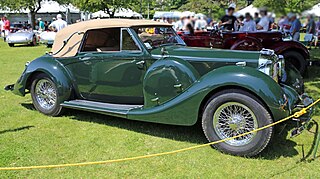
The Lagonda V12 is a large car produced by the British Lagonda company from 1938 to 1940. It was first shown at the 1936 London Motor Show but production did not commence until 1938.

The Vauxhall Big 6 is a name given to a series of automobiles which was produced by Vauxhall in the United Kingdom from 1934 to 1940. Rolling chassis were also bodied in Australia.
















